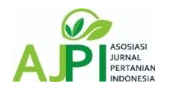Testing The Physicochemical Properties Of Liquid Organic Fertilizer Waste Of Spincord Fish (Channa Striata)
DOI:
https://doi.org/10.58794/juragan.v2i2.964Keywords:
Waste, Snakehead Fish (Channa striata), POCAbstract
Fish wealth in the Indonesian region is abundant and efforts are continuously being made to increase the catch. Abundant fish catches become leftover fish or discarded fish due to various reasons, for example the fishermen's limited knowledge and facilities in fish processing methods. It turns out that the remaining fish or discarded fish can still be used. Nowadays snakehead fish (Channa striata) is widely used to make fish sauce, but in the manufacturing process only the flesh is used, this causes the skin and bones to become unusable waste. In general, fish waste contains many nutrients, namely N (Nitrogen), P (Phosphorus) and K (Potassium), which are components of organic fertilizer.The increase in waste production greatly influences global warming which triggers climate change. With proper processing in accordance with the environment and its presence in the environment, it is hoped that the environment will be clean, healthy and comfortable, in addition, appropriate waste can produce use value that will add income. From the research results, it can be concluded that the addition of the bromelain enzyme with a concentration of 150 mL produces the highest nitrogen content, namely 0.39%, while for the phosphorus content, the addition of 150 mL of enzyme shows a higher value, namely 0.168% and the highest nitrogen content, namely 0.037%, is owned by POC with the addition of 150 mL of bromelain enzyme.
References
Barus, A. et al. (2022) ‘Pelatihan Pembuatan Pupuk Organik Berbahan Baku Tandan Kosong Kelapa Sawit (TKKS) dan Evaluasi Kinerja Komposter, di Desa Lantasan Baru, Patumbak, Kabupaten Deli Serdang’, Jurnal Apitek, 1(2), pp. 1–3. Available at: https://akses.ptki.ac.id/jurnal/index.php/apitek/article/view/44.
Fitri, R.R. and Asih, E.R. (2019) ‘Pemanfaatan Ikan Gabus (Channa Striata) Dan Tomat (Lypersion Esculentum Mill) Sebagai Penyedap Rasa Alami’, Jurnal Proteksi Kesehatan, 7(2), pp. 94–100. Available at: https://doi.org/10.36929/jpk.v7i2.146.
Hardjata, D.A., Romadhon and Rianingsih, L. (2020) ‘Karakteristik Fisiko-Kimia Skin Lotion Ekstrak Albumin Ikan Gabus (Channa striata)’, Jurnal; Ilmu dan Teknologi Perikanan, 21(1), pp. 1–9.
Kustiani, E. and Saptorini, S. (2019) ‘Optimalisasi Dosis Pupuk Organik Cair Mikroorganisme Lokal Terhadap Pertumbuhan Sawi Daging’, Jurnal Agrinika : Jurnal Agroteknologi dan Agribisnis, 3(1). Available at: https://doi.org/10.30737/agrinika.v3i1.634.
Miarti, A. and Legasari, L. (2022) ‘Ketidakpastian Pengukuran Analisa Kadar Biuret, Kadar Nitrogen, Dan Kadar Oil Pada Pupuk Urea Di Laboratorium Kontrol Produksi Pt Pupuk Sriwidjaja Palembang’, Jurnal Cakrawala Ilmiah, 2(3), pp. 861–874.
Notanubun, R. and Mussadun (2017) ‘Kajian Pengembangan Konsep Waterfront City di Kawasan Pesisir Kota Ambon’, Jurnal Pembangunan Wilayah dan Kota, 13(2), pp. 243–255. Available at: https://ejournal.undip.ac.id/index.php/pwk/article/view/15836.
Nurjannah, N.R., Sudiarti, T. and Rahmidar, L. (2020) ‘Sintesis dan Karakterisasi Selulosa Termetilasi sebagai Biokomposit Hidrogel’, al-Kimiya, 7(1), pp. 19–27. Available at: https://doi.org/10.15575/ak.v7i1.6490.
Prasetya, I.S. et al. (2023) ‘Kontribusi Budidaya Keramba Jaring Apung terhadap Peningkatan Faktor Pembatas Fosfor dan Nitrogen di Ekosistem Waduk Pulau Jawa’, Maiyah, 2(4), p. 284. Available at: https://doi.org/10.20884/1.maiyah.2023.2.4.9956.
Santosa, B. (2020) ‘Antigen Non Struktural 1 (Ns1) Sebagai Marker Suspek Infeksi Dengue’, Jurnal Media Analis Kesehatan, 11(1), p. 27. Available at: https://doi.org/10.32382/mak.v11i1.1476.
Susi, N., Mutryarny, E. and M.Rizal (2015) ‘Pengujian Mikroorganisme Lokal ( Mol) Limbah Kulit Nenas Terhadap Pertumbuhan Dan Produksi Tanaman Caisim ( Brassica juncea L)’, Jurnal Ilmiah Pertanian, 1(1), pp. 44–51.









